| Listing 1 - 10 of 10 |
Sort by
|
Book
ISBN: 0415037123 0415114780 9780415114783 9781315004006 9781136157608 9781136157677 9781136157745 9781138130333 1299699839 1136157670 1138130338 1136157603 1315004003 Year: 1993 Publisher: London ; New York Routledge
Abstract | Keywords | Export | Availability | Bookmark
 Loading...
Loading...Choose an application
- Reference Manager
- EndNote
- RefWorks (Direct export to RefWorks)
Civilization --- Consumer goods --- Consumers --- Consumption (Economics) --- Customers (Consumers) --- Shoppers --- Persons --- Consumer products --- Consumers' goods --- Goods, Consumer --- Commercial products --- Cultural history --- History --- History of civilization --- History of Europe --- anno 1600-1699 --- anno 1700-1799 --- Food consumption --- Aliments --- Biens de consommation --- Consommation --- Histoire --- Sociology of cultural policy --- Consumer behavior --- popular culture --- bookstores --- literacy --- personalia --- bookselling --- geletterdheid --- consumptiegoederen --- consumptie --- bookstores [built works] --- cultuurgeschiedenis --- cultuurparticipatie --- cultuursociologie --- consumentengedrag
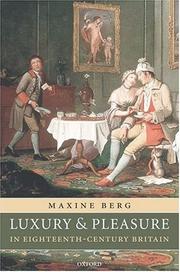
ISBN: 9780199215287 9780199272082 0199215286 0199272085 1281346063 019153403X 0191695939 1435606949 Year: 2005 Publisher: Oxford : Oxford university press,
Abstract | Keywords | Export | Availability | Bookmark
 Loading...
Loading...Choose an application
- Reference Manager
- EndNote
- RefWorks (Direct export to RefWorks)
The fine mahogany secretaire with its secret drawers, the lacquered tea table, Chinese and Japanese porcelain tea ware. These fine luxury goods now seem to belong to the English country house or the exclusive antique shop. But what do they tell us about their eighteenth-century consumers? Who owned these goods, what made them desirable, where did they come from, and how were they made? And how many people actually enjoyed their novelty and fashion? In Luxury and Pleasure in. Eighteenth-Century Britain Maxine Berg explores not only how luxury consumer goods transformed the homes of Britain's ur
Consumption (Economics) --- Consumer goods --- Luxury goods industry --- Middle class --- Consommation (Economie politique) --- Biens de consommation --- Produits de luxe --- Classes moyennes --- History --- Economic aspects --- Histoire --- Aspect économique --- Industrie --- Great Britain --- Grande-Bretagne --- Social conditions --- Conditions sociales --- Affluent consumers --- Bourgeoisie --- Commons (Social order) --- Middle classes --- Social classes --- Industries --- Consumer demand --- Consumer spending --- Consumerism --- Spending, Consumer --- Demand (Economic theory) --- Consumer products --- Consumers' goods --- Goods, Consumer --- Commercial products --- Affluent market --- Rich as consumers --- Rich consumers --- Wealthy consumers --- Consumers --- 18th century --- Affluent consumers. --- Consumer goods. --- Consumption (Economics). --- Luxury goods industry. --- Middle class. --- History of civilization --- History of the United Kingdom and Ireland --- luxury
Book
ISBN: 9782503580111 9782503580128 2503580114 Year: 2018 Publisher: Turnhout Brepols
Abstract | Keywords | Export | Availability | Bookmark
 Loading...
Loading...Choose an application
- Reference Manager
- EndNote
- RefWorks (Direct export to RefWorks)
A new, scholarly, and lively appraisal of the twin paradigms of Luxury and Greed as they were debated, disseminated, enacted, and feigned in early modern Italy.This book unravels the complex interaction of the paradigms of luxury and greed which lie at the origins of modern consumption practices. In the Western world, the phenomenon of luxury and the ethical dilemmas it raised appeared, for the first time since antiquity, in early modern Italy. Here, luxury emerged as a core idea in the conceptualization of consumption. Simultaneously, greed — which manifested in new and unrestrained consumption practices — came under close ethical scrutiny. As the buying power of new classes gained pace, these paradigms evolved as they continued both to influence, and be influenced by, other emerging global cultures through the early modern period.After defining luxury and greed in their historical contexts, the volume’s chapters elucidate new consumptive goods, from chocolate to official robes of state; they examine how ideas about, and objects of, luxury and greed were disseminated through print, diplomacy, and gift-giving; and they reveal how even the most elite of consumers could fake their luxury objects. A group of international scholars from a range of disciplines thereby provide a new appraisal and vision of luxury and the ethics of greed in early modern Italy
Consumption (Economics) --- Consommation --- Luxury --- Luxe --- History --- Moral and ethical aspects --- History. --- Aspect moral --- Histoire. --- History of Italy --- anno 1400-1499 --- anno 1500-1599 --- Economics --- Wealth --- Cost and standard of living --- Leisure class --- Consumer demand --- Consumer spending --- Consumerism --- Spending, Consumer --- Demand (Economic theory) --- Moral and ethical aspects&delete& --- luxury
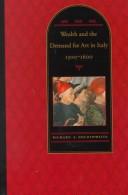
ISBN: 0801846129 Year: 1993 Publisher: Baltimore, Md Johns Hopkins University Press
Abstract | Keywords | Export | Availability | Bookmark
 Loading...
Loading...Choose an application
- Reference Manager
- EndNote
- RefWorks (Direct export to RefWorks)
History --- Renaissance --- art market --- Art --- anno 1500-1599 --- Italy --- History of civilization --- anno 1400-1499 --- anno 1300-1399 --- 7.078.2 --- 7.034 <45> --- 7:33 --- Wealth --- -Art patronage --- -Art, Renaissance --- -Consumption (Economics) --- -Consumer demand --- Consumer spending --- Consumerism --- Spending, Consumer --- Demand (Economic theory) --- Art, Renaissance --- Renaissance art --- Arts patronage --- Business patronage of the arts --- Corporations --- Maecenatism --- Patronage of art --- Art and industry --- Affluence --- Distribution of wealth --- Fortunes --- Riches --- Business --- Economics --- Finance --- Capital --- Money --- Property --- Well-being --- Kunstbescherming door particulieren: sponsoring; mecenaat --- Kunst van de renaissance; barok; rococo; koloniale stijl--Italië --- Kunst. Ruimtelijke ordening. Architectuur. Sport en spel-:-Economie. Economische wetenschappen. Staatshuishoudkunde --(algemeen) --- Art patronage --- -Kunstbescherming door particulieren: sponsoring; mecenaat --- 7:33 Kunst. Ruimtelijke ordening. Architectuur. Sport en spel-:-Economie. Economische wetenschappen. Staatshuishoudkunde --(algemeen) --- 7.034 <45> Kunst van de renaissance; barok; rococo; koloniale stijl--Italië --- 7.078.2 Kunstbescherming door particulieren: sponsoring; mecenaat --- -Demand (Economic theory) --- Consumer demand --- -7.078.2 Kunstbescherming door particulieren: sponsoring; mecenaat --- Consumption (Economics) --- Kunst --- Cultuurgeschiedenis --- kunstmarkt --- renaissance --- Italië
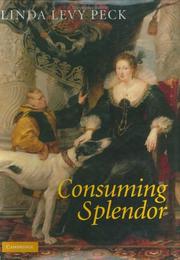
ISBN: 0521842328 9780521842327 Year: 2005 Publisher: Cambridge : Cambridge university press,
Abstract | Keywords | Export | Availability | Bookmark
 Loading...
Loading...Choose an application
- Reference Manager
- EndNote
- RefWorks (Direct export to RefWorks)
History of civilization --- History of the United Kingdom and Ireland --- anno 1600-1699 --- Consumption (Economics) --- Luxuries --- Shopping --- Consommation (Economie politique) --- Propduits de luxe --- Magasinage --- History --- Histoire --- England --- Great Britain --- Angleterre --- Grande-Bretagne --- Social life and customs --- Economic conditions --- Moeurs et coutumes --- Conditions économiques --- Conditions économiques --- Buyers' guides --- Shoppers' guides --- Purchasing --- Retail trade --- Consumer education --- Personal shoppers --- Luxury goods --- Luxury services --- Commercial products --- Consumer demand --- Consumer spending --- Consumerism --- Spending, Consumer --- Demand (Economic theory) --- 17th century --- Objets de luxe --- Stuarts, 1603-1714
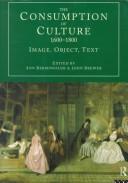
ISBN: 0415121353 0415159970 Year: 1995 Volume: 3 Publisher: New York ; London Routledge
Abstract | Keywords | Export | Availability | Bookmark
 Loading...
Loading...Choose an application
- Reference Manager
- EndNote
- RefWorks (Direct export to RefWorks)
Consumption (Economics) --- Culture --- Consommation (Economie politique) --- History --- Histoire --- Europe --- Great Britain --- Grande-Bretagne --- Civilization --- Social life and customs --- Civilisation --- Moeurs et coutumes --- 930.85.47 --- 930.85.48 --- Cultuurgeschiedenis: Barok --- Cultuurgeschiedenis: Verlichting; Aufklärung --- 930.85.48 Cultuurgeschiedenis: Verlichting; Aufklärung --- 930.85.47 Cultuurgeschiedenis: Barok --- History. --- #SBIB:93H3 --- Thematische geschiedenis --- Art --- History of civilization --- anno 1600-1699 --- anno 1700-1799 --- 18th century --- 17th century --- Kunst --- Cultuurgeschiedenis --- consumptie van kunst --- cultuurgeschiedenis
Book
ISBN: 9789058264589 9058264580 Year: 2007 Publisher: Leuven : Davidsfonds,
Abstract | Keywords | Export | Availability | Bookmark
 Loading...
Loading...Choose an application
- Reference Manager
- EndNote
- RefWorks (Direct export to RefWorks)
History of civilization --- History of the Low Countries --- Drinking of alcoholic beverages --- Beverages --- Consommation d'alcool --- Boissons --- History --- Histoire --- België --- Nederland --- voedsel --- drank --- Drinking customs --- 933.9 --- drinken --- Lage Landen --- 949.32 LEUVEN --- C3 --- overzicht --- cultuurgeschiedenis (x) --- Nederland [land in werelddeel Europa] --- Vlaams Gewest [gewest in land België - BE] --- brouwerij (x) --- alcoholgebruik (x) --- 906.4 --- Bier --- Geschiedenis --- Nederlanden --- Wijn --- cultuurgeschiedenis België- bijzondere onderwerpen --- Geschiedenis van België: hertogdom Brabant; provincie Brabant--(reg./lok.)--LEUVEN --- Kunst en cultuur --- History. --- 949.32 LEUVEN Geschiedenis van België: hertogdom Brabant; provincie Brabant--(reg./lok.)--LEUVEN --- België. --- Nederland. --- Alcohol consumption --- Alcohol drinking --- Alcohol use --- Alcoholic beverage consumption --- Consumption of alcoholic beverages --- Drinking problem --- Liquor problem --- Social drinking --- Alcoholic beverages --- Alcoholism --- Temperance --- Manners and customs --- Drinks --- Potable liquids --- Potables --- Food --- Liquids --- Drinks and drinking --- Belgium --- Netherlands --- drinks --- 950 --- cultuurgeschiedenis --- dranken --- voeding geschiedenis --- histoire culturelle --- Drinking customs - Belgium - History --- Drinking customs - Netherlands - History --- Drinking of alcoholic beverages - Belgium - History --- Drinking of alcoholic beverages - Netherlands - History --- Beverages - Belgium - History --- Beverages - Netherlands - History --- Pays-Bas --- Boisson --- drankcultuur --- geschiedenis --- wijn --- bier
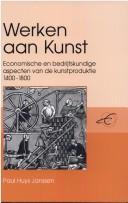
ISBN: 9065504257 Year: 1995 Volume: XXII Publisher: Hilversum Verloren
Abstract | Keywords | Export | Availability | Bookmark
 Loading...
Loading...Choose an application
- Reference Manager
- EndNote
- RefWorks (Direct export to RefWorks)
Art --- History of Europe --- anno 1500-1799 --- anno 1400-1499 --- History --- Wedgwood, Josiah --- Rembrandt --- Rubens, Peter Paul --- Arts and society --- Arts et société --- Kunsten en maatschappij --- 7.075 --- Kunsthandel. Kunstbemiddeling. Activiteiten van promotors; managers; producers --- 7.075 Kunsthandel. Kunstbemiddeling. Activiteiten van promotors; managers; producers --- Consumption (Economics) in art --- Art, Occidental --- Art, Visual --- Art, Western (Western countries) --- Arts, Fine --- Arts, Visual --- Fine arts --- Iconography --- Occidental art --- Visual arts --- Western art (Western countries) --- Arts --- Aesthetics --- Economic aspects&delete& --- Economic aspects --- Kunst --- Geschiedenis van Europa --- Art, Primitive
Book
ISBN: 9781472451965 9781315573311 9781317162384 9781317162391 9780367598280 Year: 2015 Volume: *5 Publisher: Aldershot [etc.] Ashgate
Abstract | Keywords | Export | Availability | Bookmark
 Loading...
Loading...Choose an application
- Reference Manager
- EndNote
- RefWorks (Direct export to RefWorks)
"The dominance of economic repertories of value is a relatively new phenomenon, and one which directly correlates to the steady advent of capitalism in early modern Europe. This volume brings together scholars with expertise in a variety of related fields, including economic history, the history of consumption and material culture, art history, and the history of collecting, to explore changing concepts of value from the early modern period to the nineteenth century and present a new view on the advent of modern economic practices. Jointly, they fundamentally challenge traditional historical narratives about the rise of our contemporary market economy and consumer society"--
History of Europe --- anno 1500-1799 --- anno 1800-1899 --- Consumption (Economics) --- Material culture --- Capital market --- Fair value --- Valuation --- Consommation (Economie politique) --- Culture matérielle --- Marché financier --- Juste valeur --- Valuation, Theorie des --- History. --- Histoire --- Accounting --- Appraisal --- Capitalization (Finance) --- Economic valuation --- Property --- Value --- Public utilities --- Fair market value --- Finance --- Financial institutions --- Loans --- Money market --- Securities --- Crowding out (Economics) --- Efficient market theory --- Capital markets --- Market, Capital --- Culture --- Folklore --- Technology --- Demand (Economic theory) --- Consumer demand --- Consumer spending --- Consumerism --- Spending, Consumer --- Rates --- History --- Culture matérielle --- Marché financier --- Geschiedenis van Europa
Multi
ISBN: 9789463720625 9789048550050 904855005X 9463720626 Year: 2020 Publisher: Amsterdam Amsterdam University Press
Abstract | Keywords | Export | Availability | Bookmark
 Loading...
Loading...Choose an application
- Reference Manager
- EndNote
- RefWorks (Direct export to RefWorks)
In this study, the appearance and location of shops in Amsterdam during the early modern period is linked to major changes in the urban economy, the size and socio-spatial distribution of its population, and the structure of the urban grid. Not only is there ample attention for the spatial distribution of shops across the urban landscape, but for the first time it is also accurately charted what the exterior and interior of Amsterdam shops looked like and how they changed in the course of the centuries. Partly as a result of this, it has proved possible to give an impression of the ways in which retailers and customers interacted.
Economic infrastructure --- Environmental planning --- Economic geography --- History of the Netherlands --- urban history --- stores --- urban landscapes --- anno 1500-1799 --- anno 1800-1899 --- Amsterdam --- Stores, Retail --- City planning --- Urban landscape architecture --- History --- Amsterdam (Netherlands) --- Commerce --- History. --- E-books --- Landscape architecture --- Cities and towns --- Civic planning --- Land use, Urban --- Model cities --- Redevelopment, Urban --- Slum clearance --- Town planning --- Urban design --- Urban development --- Urban planning --- Land use --- Planning --- Art, Municipal --- Civic improvement --- Regional planning --- Urban policy --- Urban renewal --- Retail stores --- Shops --- Commercial buildings --- Retail trade --- Shopping centers --- Government policy --- Management --- Amesterdão (Netherlands) --- Amstelodamum (Netherlands) --- Amstelaedamum (Netherlands) --- Amstelredamum (Netherlands) --- Amsterodamum (Netherlands) --- Amstelrodamum (Netherlands) --- Retail location, shopping streets, shop design, architecture, consumption spaces. --- stores [built works]
| Listing 1 - 10 of 10 |
Sort by
|

 Search
Search Feedback
Feedback About UniCat
About UniCat  Help
Help News
News